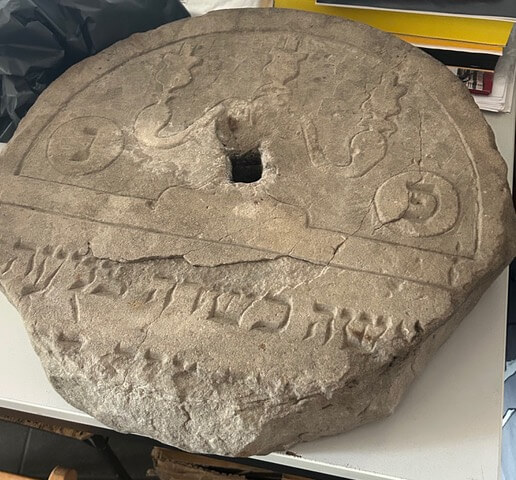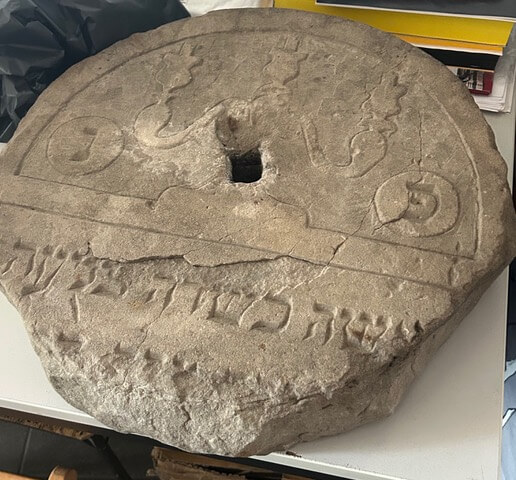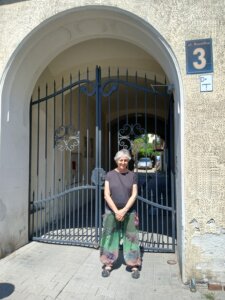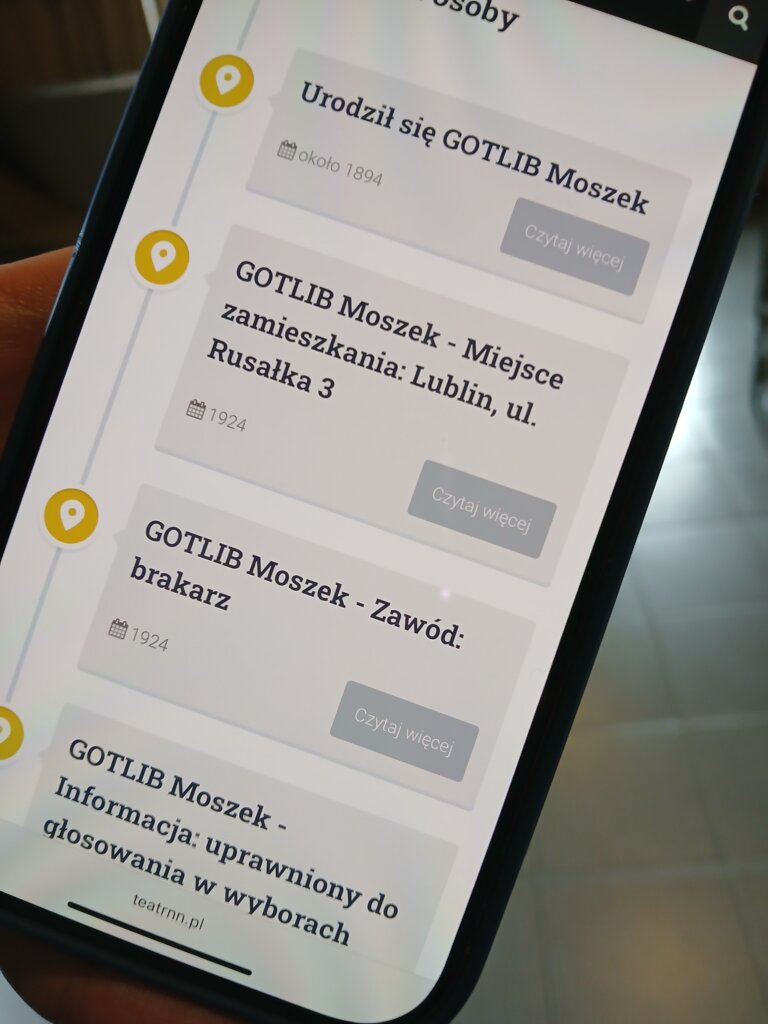Uncategorized
The treasures discovered by a group of non-Jews in Lublin

דער פּאָעט יעקבֿ גלאַטשטיין, אַ געבוירענער אין לובלין, פּוילן, האָט געשריבן:
לובלין, מײַן הייליקע ייִדישע שטאָט, שטאָט פֿון גרויסן דלות און פֿריילעכע ייִדישע יום־טובֿים…
שטאָט פֿון אויפֿגעוואַכטן קלאַסנקאַמף. . . .
לובלין, מײַן הייליקע ייִדישע שטאָט פֿון בילדונג־דאָרשטיקע יונגע־לײַט און יונגע מיידלעך, פֿון דעם ערשטן בעז־אַראָמאַט פֿון יונג־העברעיִש און פֿון דער באַטעמטקייט פֿון שטאָלצן ייִדיש.
הייליקע שטאָט מײַנע, . . . ווער וועט דיך צוריקשטעלן און צוריקבויען, מײַן הייליקע שטאָט, אַז פֿאַרוויסט ביסטו געוואָרן ביז דײַנע פֿונדאַמענטן און ביסט איין מוראדיקע מצבֿה.
מע שלאָגט שינדלען, מע לייגט דעכער, מען פֿאַרריכט און מען פֿאַרניצעוועט אַן אַלטע פּאַסקודנע וועלט, אָבער מײַן הייליקע שטאָט, די שטאָט פֿון מײַן וועלט, וועט קיין מאָל נישט צוריקגעבויט ווערן.
גלאַטשטיין איז געווען גערעכט. זײַן הייליקע שטאָט לובלין, די שטאָט פֿון אַרום 43,000 ייִדן פֿאַר דעם חורבן, כּמעט אַ דריטל פֿון דער דעמאָלטיקער באַפֿעלקערונג, וועט קיין מאָל נישט צוריקגעבויט ווערן, אָבער עס זײַנען דאָ מענטשן און אַן אָרגאַניזאַציע, דווקא נישט קיין ייִדן און נישט קיין ייִדישע, וואָס אַרבעטן כּדי אויפֿצוהאַלטן דעם אָנדענק פֿון יענער הייליקער ייִדישער שטאָט. די אָרגאַניזאַציע הייסט „בראַמאַ גראָדסקאַ”, (דער שטאָטטויער) און עס געפֿינט זיך אין אַ בנין אין דעם טויער, וואָס ייִדן פֿלעגן רופֿן „גראָדסקע בראָם“ אָדער „ברום“, דורך וועלכן מע פֿלעגט אַרײַנגיין אין דער אַמאָליקער ייִדישע געגנט.
דעם זומער, זײַענדיק אין פּוילן האָבן מיר (מײַן מאַן, אונדזער עלטערע טאָכטער בענאַ און איך) געמאַכט אַן עקסקורסיע קיין לובלין, — די שטאָט וווּ מײַן טאַטע האָט געוווינט ווי אַ צענערלינג ביז 1927, די שטאָט פֿון זײַן אַרײַנטריט אין „אויפֿגעוואַכטן קלאַסן־קאַמף“ און „שטאָלצן ייִדיש“,— און זיך געטראָפֿן מיט פּיאָטער נאַזאַרוקן, אַ געוועזענער ייִדיש־סטודענט פֿון דער ווײַנרײַך־פּראָגראַם בײַם ייִוואָ. פּיאָטער האָט אונדז אַרומגעפֿירט איבער דער שטאָט און דערציילט וועגן דער געשיכטע און אַרבעט פֿון דער אָרגאַניזאַציע.
„בראַמאַ“ האָט זיך אָנגעהויבן אין 1990 ווי אַ טעאַטער־טרופּע אָבער מיט דער צײַט האָבן די באַטייליקטע אײַנגעזען אַז זיי געפֿינען זיך אין האַרץ פֿון עפּעס אַ סך מער דראַמאַטישס ווי די דראַמאַטישיסטע פּיעסע — דער פֿאַרלוירענער ייִדישער וועלט — און זיי האָבן אָנגעווענדט זייערע כּוחות און פֿעיִקייטן אויף רעקאָנסטרוּירן און אויפֿהיטן די געשיכטע פֿון יענער וועלט.
שטעלט זיך די פֿראַגע, פֿאַר וואָס וואָלטן נישט־ייִדן זיך אָפּגעגעבן מיט אויפֿהיטן דעם אָנדערק פֿון די ייִדן? און די פֿראַגע קומט טאַקע דעם גאַסט אַנטקעגן ווען מע טרעט אַרײַן אינעם בנין. אויף דער וואַנט הענגט אַן אויפֿשריפֿט אין דרײַ שפּראַכן: פּויליש, ענגליש און עבריתּ בזה הלשון: „ייִדן וואָס קומען אַהער פֿרעגן אונדז, איר זײַט דאָך נישט קיין ייִדן. איר זײַט פּאָליאַקן און די ייִדישע שטאָט איז ניט אײַער געשיכטע. פּאָליאַקן פֿרעגן אונדז, ,פֿאַר וואָס טוט איר דאָס, איר זײַט דאָך פּאָלאַקן און די ייִדישע שטאָט איז ניט אײַער געשיכטע. אָדער אפֿשר זײַט איר טאַקע ייִדן?
„געדולדיק גיבן מיר צו פֿאַרשטיין אַז דאָס איז אונדזער בשותּפֿותדיקע פּויליש־ייִדישע געשיכטע. צו געדענקען די אויסגעהרגעטע ייִדן דאַרף מען נישט זײַן קיין ייִד.“
אויף אַן אַנדער וואַנטשילד שטייט געשריבן: „עס איז דאָ, בײַם גראָדסקע־טויער, וואָס מע רופֿט אויך ׳דער ייִדישער טויער׳, וואָס איז דער שומר איבער דעם נישט־עקסיסטירנדיקן שטעטל — דעם ייִדישן אַטלאַנטיס — וווּ מיר באַמיִען זיך צו פֿאַרשטיין דעם באַטײַט און דעם שליחות פֿון דעם אָרט הײַנט.“
עס זײַנען דאָ פֿאַרשיידענע אופֿנים און פּראָיעקטן דורך וועלכע זיי טוען דאָס. איינער אַזאַ האָט צו טאָן מיט פֿאָטאָגראַפֿיעס. אין 2015 האָט בראַמאַ גראַדסקאַ באַקומען אַן אוצר, אַ זאַמלונג גלעזערנע נעגאַטיוון (glass plate negatives, בלע״ז) וואָס אַרבעטערס האָבן צופֿעליק געפֿונען אין אַ בוידעם אויף רינעק 4. דער פֿאָרשער יעקבֿ כמיעלעווסקי אין מײַדאַנעק האָט אַנטדעקט אַ מעגלעכע פֿאַרבינדונג צווישן דעם אַדרעס און אַ פֿאָטאָגראַף, אַבראַם זילבערבערג, וואָס האָט דאָרטן אַ שטיק צײַט געוווינט.
די זאַמלונג איז כּולל מער ווי 2,700 גלעזערנע נעגאַטיוון פֿון פֿאַרשיידענע גרייסן, פֿון בילדער גענומען צווישן 1914 און 1939. ניט געקוקט אויף די 75 יאָר, די נישט־גינסטיקע באַדינגונגען אין בוידעם — די קעלט ווינטערצײַט און די היצן זומערצײַט — האָבן ס׳רובֿ פֿון די נעגאַטיוון זיך אויפֿגעהיט. זיי געבן דעם צוקוקער אַ בליק אַרײַן אין דעם וואָס זיי רופֿן „אַ נישט־עקסיסטירנדיקע שטאָט“: בילדער פֿון קינדער און דערוואַקסענע, מענער און פֿרויען, פֿרומע און וועלטלעכע, ייִדן און נישט־ייִדן, פֿאַרשיידענע פֿאַכלײַט, יחידים און גרופּעס, יוגנט־באַוועגונגען און ספּאָרטקלובן.
אַנדערע בילדער פֿון חתונות, בריתן און מצבֿות דאָקומענטירן וויכטיקע מאָמענטן אין דעם ייִדישן משפּחה־לעבן. די פֿאָטאָגראַפֿיעס שפּיגלען אויך אָפּ דעם בהדרגהדיקן איבערגאַנג פֿון אַ פֿרום, טראַדיציאָנעל לעבן צו אַ מער וועלטלעכן. דאָס רובֿ זײַנען בילדער פֿון פּשוטע לײַט, אין גאַנג פֿון דער טאָג־טעגלעכקייט — מענטשן וואָס האָבן קיין מאָל נישט געמיינט אַז זיי וועלן ווערן שטומע עדות אויף אַ פֿאַרשוווּנדענער וועלט.
אַן אַנדער פּראָיעקט האָט צו טאָן מיט דער דיגיטאַלער ביבליאָטעק פֿון דער ישיבֿת חכמי לובלין, אַ וויכטיקער מקום־תּורה וואָס האָט זיך געעפֿנט אין לובלין אין 1930, און איז געווען רעוואָלוציאָנער אין דער ישיבֿה־וועלט, נישט נאָר פֿאַר דעם דף־יומי וואָס איר פֿאַרלייגער, ר’ מאיר שאַפּיראָ, האָט אײַנגעפֿירט אויף אַ קאָנפֿערענץ פֿון אַגודת־ישׂראל אין ווין אין 1923, נאָר אויך פֿאַר איר שיינעם בנין וואָס האָט געהאַט אַן עסזאַל און אינטערנאַטן פֿאַר די בחורים, אַ סגולה צו די שוועריקייטן פֿון דינגען אַ צימער און עסן טעג אין פֿרעמדע הײַזער.
במשך פֿון די קנאַפּע צען יאָר פֿון איר עקסיסטענץ, פֿון 1930־1939, האָט די ישיבֿה אָנגעזאַמלט אַ ביבליאָטעק פֿון צענדליקער טויזנט ספֿרים, ביכער און צײַטשריפֿטן. אין 1941 האָבן די נאַציס אײַנגענומען לובלין און ביז מיט אַ יאָרצענדליק צוריק האָט מען געמיינט אַז נאָר פֿינעף ביכער האָבן זיך געראַטעוועט. אָבער אַ דאַנק דער איבערגעגעבענער אַרבעט פֿון בראַמאַ גראָדסקאַ, אונטער דער אָנפֿירערשאַפֿט פֿון פּיאָטער נאַזאַרוק און מאָניקאַ טאַרײַקאָ, האָבן זיך שוין אָפּגעזוכט ביז הײַנט 1,555 ביכער, פֿונאַנדערגעשפּרייט אין ביבליאָטעקן איבער דער גאָרער וועלט.
בראַמאַ גראָדסקאַ ווייסט אַז ס׳איז נישטאָ קיין שׂכל אין צוריקברענגען די ביכער קיין לובלין, אַ שטאָט וואָס האָט קוים אַ מנין ייִדן. דערפֿאַר צילעווען זיי מיט זייער דיגיטאַלער ביבליאָטעק אויסצוזוכן, אידענטיפֿיצירן און קאַטאַלאָגירן אַלע ביכער מיט שטעמפּלען פֿון דער ישיבֿה. אַזוי האָפֿן זיי צו רעסטאַוורירן די זאַמלונג און זי כאָטש סימבאָליש צוריקקערן קיין לובלין.
אַזוי ווי בראַמאַ גראָדסקאַ דינט ווי דער אַדרעס פֿאַר אויפֿהיטן דעם אָנדענק פֿון די ייִדן אין לובלין קען מען דאָרטן געפֿינען אויסטערלישע זאַכן וואָס מענטשן האָבן צופֿעליק געפֿונען און אַהין אַרײַנגעגעבראַכט: למשל, אַ וואָגנראָד וואָס האָט זיך ערגעץ געוואַלגערט, געמאַכט פֿון אַ ייִדישער מצבֿה, אַן עדות אויף אַנטיסעמיטישן וואַנדאַליזם.

בראַמאַ פֿירט אויך אָן מיט דערציִערישע פּראָגראַמען וועגן דעם חורבן און דעם ייִדישן לעבן פֿאַר דעם חורבן פֿאַר לערערס פֿון פּוילן און פֿון אויסלאַנד. זיי האָבן אַ דאַטן־באַזע וווּ זיי זאַמלען אינפֿאָרמאַציע וועגן געוועזענע לובלינער פֿון פֿאַרשיידענע מקורים, ווי למשל, רשימות פֿון אײַנוווינערס פֿון בנינים און שטים־רשימות.

איך האָב, פֿאַרשטייט זיך, געבעטן בײַ פּיאָטערן ער זאָל זוכן אינפֿאָרמאַציע וועגן מײַנע אייגענע אָבֿות, דער משפּחה צוקער. האָט ער געזוכט אונטער זייער אַדרעס, רוסאַלקע 3, וווּ ער האָט אונדז פֿריִער געהאַט געפֿירט. צווישן די אַלע נעמען פֿון די אײַנוווינערס פֿון בנין וואָס האָבן זיך געפֿונען אין דער דאַטן־באַזע, בתוכם נישט קיין איין צוקער (מסתּמא ווײַל די משפּחה איז שוין געהאַט אַוועק פֿון לובלין אין די סוף צוואַנציקער יאָרן) האָט איין נאָמען מיר פֿאַרכאַפּט דעם אָטעם: מאָשעק (משה) גאָטליב, פֿון פֿאַך אַ בראַקער.
איך האָב קיין מאָל נישט געטראָפֿן משה גאָטליבן. געוווּסט האָב איך נאָר אַז ער איז געווען דער ערטשער מאַן פֿון דעם טאַטנס עלטסטער שוועסטער לובע און אַז זיי האָבן נאָך אַ פּאָר יאָר זיך געגט. כאָטש די מומע לובע איז שוין געווען אַ בונדיסטקע האָט זי מסכּים געווען צו אַ שידוך (איך ווייס ניט צי פֿרײַוויליק צי נישט) מיטן זון פֿון איינעם אַ גאָטליב מיט וועמען דער טאַטע (מײַן זיידע), אויך אַ בראַקער, האָט געהאַט געשעפֿטן.
מיר איז דאָס אַלע מאָל געווען אַזאַ אינטערעסאַנטער באַווײַז פֿון דעם וואָס ווי די אַלטע וועלט און די נײַע זײַנען דעמאָלט געווען געקניפּט און געבונדן. נאָך אַלעמען, ווי קומט אַ בונדיסטקע צו אַ שידוך?! מער ווי דאָס האָב איך וועגן משה גאָטליבן נישט געוווּסט. ס׳איז מיר קיין מאָל אַפֿילו נישט אײַנגעפֿאַלן צו פֿרעגן אויב ער איז אומגעקומען אָדער האָט איבערגעלעבט דעם חורבן; בײַ מיר האָט זײַן שייכות צו מײַן משפּחה זיך געענדיקט מיטן גט ערגעץ אין די 20ער יאָרן. נאָר ס׳איז קלאָר אַז ער איז אומגעקומען.
איך האָב געקענט זייער זון איצוש ע״ה, וואָס האָט אין די 1950ער יאָרן עמיגרירט קיין קאַנאַדע, וווּ מיר האָבן געוווינט, נאָר ס׳איז מיר אויך קיין מאָל נישט אײַנגעפֿאַלן אים צו פֿרעגן וואָס איז געשען מיטן טאַטן זײַנעם. צי האָט ער נאָך אַ מאָל חתונה געהאַט, האָט ער געהאַט אַנדערע קינדער — האַלבע־ברידער אָדער ־שוועסטער? זײַנען זיי אויך אומגעקומען?

מסתּמא וועל איך קיין מאָל נישט האָבן קיין ענטפֿער אויף די פֿראַגעס אָבער די קנאַפּע ידיעות האָבן אויפֿגעלעבט פֿאַר מיר אויף אַ פּאָר מינוט אַ מענטשן. דאָס איז טאַקע דער ציל פֿון בראַמאַ גראָדסקאַ — צו ווײַזן אַז די אומגעקומענע זײַנען נישט געווען בלויז ציפֿערן. דאָס ביסל אינפֿאָרמאַציע וועגן משה גאָטליבן איז אַרײַן אין איינער פֿון די 43,000 פּאַפּקעס — איין פּאַפּקע פֿאַר יעדן אומגעקומענעם ייִד, וואָס האָט געוווינט אין לובלין ערבֿ דעם אויסבראָך פֿון דער מלחמה.
און דווקא יענע דינע פּאַפּקעס האָבן מער פֿון אַלע פּראָיעקטן און חפֿצים, געמאַכט אויף מיר דעם גרעסטן אײַנדרוק. בראַמאַ צילעוועט צו געפֿינען עפּעס אַ ידיעה וועגן יעדן פֿון די 43,000 קדושים. עס קען זײַן אַ נאָמען, אַן אַדרעס, אַ פֿאַך, אַ געבוירן־טאָג, עפּעס וואָס ראַטעוועט דעם נאָמען פֿון אַנאָנימקייט און אָטעמט אַרײַן אין אים אַ נשמה.
וועגן 35,000 פֿון די אַמאָליקע אײַנוווינער האָט מען שוין עפּעס אַנטדעקט. געבליבן זײַנען נאָך 8,000 נשמות וואָס וואַרטן אויף אַ תּיקון.
The post The treasures discovered by a group of non-Jews in Lublin appeared first on The Forward.
Uncategorized
The call of this Hanukkah moment remains simple and urgent: Light candles everywhere. Even when we’re under attack.
The massacre in Sydney has left Jews around the world shaken and grieving. This act is far more than a heinous crime: It is a regression to darker times, when Jewish visibility itself carried mortal risk.
The commandment of Hanukkah is not simply to light candles, but to light them publicly – pirsumei nisa, the publicizing of the miracle. The point is not private consolation, but shared visibility. Jewish survival, the tradition teaches, is not meant to occur behind closed doors, but in full view.
Historically, however, it rarely did. In exile, Jews learned caution. The Talmud records how, in times of danger, the candles are to be moved indoors – lit discreetly, shielded from hostile eyes. This was not a theological revision but a concession to reality: When the public sphere is unsafe, Jewish life retreats into the private domain. For most of our history, this was our reality.
Modern democracies promised something different. Jews would no longer have to choose between safety and visibility. We could light openly again – on windowsills, in public squares, in front of city halls – because the surrounding society would protect us not merely by law, but by norm. Antisemitism would not just be illegal, it would be unthinkable.
The Sydney massacre, alongside countless incidents in societies Jews have long trusted, forces us to ask whether that promise is still being kept.
Jewish safety in the diaspora does not rest primarily on police presence or intelligence services – necessary though they are. It rests on something more fragile and more fundamental: a public culture in which Jews are not merely tolerated but embraced; in which antisemitism is not merely condemned after the fact but rejected instinctively and unequivocally as a violation of the moral order.
When Jews are attacked for being Jews, and the response is muted, conditional, or delayed, the message is unmistakable. Jews may still live here, but only quietly.
That is why the response to Sydney must not be withdrawal, but the exact opposite. We cannot and will not retreat into hiding our light. The call of this moment is simple and urgent: Light candles everywhere.
Jewish communities and organizations must orchestrate public Hanukkah candle lightings in the central squares of democratic cities across Europe, across the English-speaking world, wherever Jews live under the protection of free societies. Not hidden ceremonies. Not fenced-off gatherings on the margins. But civic events, hosted openly and proudly, with the participation of local and national leaders – and of fellow non-Jewish citizens.
This is not unprecedented. Every year, a Hanukkah menorah is lit at the White House. The symbolism is powerful precisely because it is mundane: Jewish light belongs at the heart of the civic space, not as an exception, not as an act of charity, but as a matter of course. That model should now be replicated widely.
Israeli diplomatic missions, together with local Jewish organizations, should work actively with municipalities and governments to make these public lightings happen – not merely as acts of Jewish resilience, but as declarations of democratic commitment. Because this is not only a Jewish question.
A society in which Jews feel compelled to hide their symbols is a society already retreating from its own values. Antisemitism is never a stand-alone phenomenon; it is the canary in the democratic coal mine. Where Jews are unsafe, pluralism is already fraying.
Lighting candles in public squares will not undo the horror of Sydney. But it will answer it – not with fear, and not with silence, but with a refusal to normalize xenophobia, antisemitism, and Jewish invisibility.
The ancient question of Hanukkah – where we light – has returned as a modern moral test of democratic societies and leaders worldwide. Where Jewish light is extinguished, democracy itself is cast into shadow. If it can still be lit openly, with the full backing of the societies Jews call home, then the promise of democratic life remains alive.
Our light must not hide. Not now. Never again.
The post The call of this Hanukkah moment remains simple and urgent: Light candles everywhere. Even when we’re under attack. appeared first on The Forward.
Uncategorized
Australia shooting terrifies Jews worldwide — and strengthens the case for Israel
If the shooters who targeted Jews on a beach in Australia while they were celebrating Hanukkah thought their cowardly act would turn the world against Israel, they were exactly wrong: Randomly killing people at a holiday festival in Sydney makes the case for Israel.
The world wants Jews to disown Israel over Gaza, but bad actors keep proving why Jews worldwide feel such an intense need to have a Jewish state.
Think about it. The vast majority of Jews who settled in Israel went there because they felt they had nowhere else to go. To call the modern state “the ingathering of exiles” softpedals reality and tells only half the story. The ingathering was a result of an outpouring of hate and violence.
Attacking Jews is the best way to rationalize Zionism.
Judaism’s holidays are often (humorously) summarized as, “They tried to kill us, they failed, let’s eat.” Zionism is simply, “They tried to kill us, they failed, let’s move.”
Theodor Herzl, the founder of modern Zionism, didn’t have a religious or even a tribal bone in his body. He would have been happy to stay in Vienna writing light plays and eating sacher torte. But bearing witness to the rise of antisemitism, he saw the Land of Israel as the European Jew’s best option.
The Eastern European pogroms, the Holocaust, the massacre of Jews in Iraq in 1941 — seven years before the State of Israel was founded — the attacks on Jews throughout the Middle East after Israel’s founding, the oppression of Jews in the former Soviet Union — these were what sent Jews to Israel.
How many Australians are thinking the same way this dark morning?
There’s a lot to worry about in Israel. It is, statistically, more dangerous to be Jewish there than anywhere else in the world. But most Jews would rather take their chances on a state created to protect them, instead of one that just keeps promising it will – especially when the government turns a blind eye to antisemitic incitement and refuses to crack down on violent protests, as Australia has.
“For over a year we have seen racist mobs impeding on the rights and freedoms of ordinary Australians. We have been locked out of parts of our cities because the police could not ensure our safety. Students have been told to stay away from campuses. We have been locked down in synagogues,” Alex Ryvchin, the co-CEO of the Executive Council of Australian Jewry, wrote a year ago, after the firebombing attack on a Melbourne synagogue.
Since then a childcare centre in Sydney’s east was set alight by vandals, cars were firebombed, two Australian nurses threatened to kill Jewish patients, to name a few antisemitic incidents. There were 1,654 antisemitic incidents logged in Australia from October 2024 to September 2025 — in a country with about 117,000 Jews.
“The most dangerous thing about terrorism is the over-reaction to it,” the philosopher Yuval Noah Harari said. He was talking about the invasion of Iraq after 9/11, the crackdown on civil liberties and legitimate protest. But surely it’s equally dangerous to underreact to terrorism and terrorist rhetoric.
Israel’s destruction of Gaza following the Hamas attack of Oct. 7, 2023 led to worldwide protests, which is understandable, if not central to why tensions have escalated.
But condemning civilian casualties and calling for Palestinian self-determination — something many Jews support — too often crosses into calls for destroying Israel, demonizing Israelis and their Jews. That’s how Jews heard the phrase “globalize the intifada” — as a justification for the indiscriminate violence against civilians.
When they took issue with protesters cosplaying as Hamas and justifying the Oct. 7 massacre, that’s what they meant. And look at what happened in Bondi Beach, they weren’t wrong. Violence leads to violence, and so does support for violence.
Chabad, which hosted the Hanukkah celebration in Sydney, has always leaned toward a more open door policy with less apparent security than other Jewish institutions. But one of the reasons it has been so effective at outreach has also made it an easy target.
As a result of the Bondi shooting, Chabad will likely increase security, as will synagogues around the world. Jewish institutions will think hard about publicly advertising their events. Law enforcement and public officials will, thankfully, step up protection, at least for a while. These are all the predictable result of an attack that, given the unchecked antisemitic rhetoric and weak responses to previous antisemitic incidents, was all but inevitable.
It’s not inevitable that Australian Jews would now move to Israel, no more than it would have been for Pittsburgh’s Jewish community to uproot itself and move to Tel Aviv after the 2018 Tree of Life massacre. That didn’t happen, because ultimately the risk still doesn’t justify it.
But these shootings, and the constant drip of violent rhetoric, vandalism and confrontation raise a question: If you want to kill Jews in Israel, and you kill them outside Israel, where, exactly, are we supposed to go?
The post Australia shooting terrifies Jews worldwide — and strengthens the case for Israel appeared first on The Forward.
Uncategorized
These are the victims of the Bondi Beach Hanukkah celebration shooting in Sydney
(JTA) — A local rabbi, a Holocaust survivor and a 12-year-old girl are among those killed during the shooting attack Sunday on a Hanukkah celebration in Sydney, Australia.
Here’s what we know about the 11 people murdered in the attack, which took place at a popular beachside playground where more than 1,000 people had congregated to celebrate the first night of the holiday, as well as about those injured.
This story will be updated.
Eli Schlanger, rabbi and father of five
Schlanger was the Chabad emissary in charge of Chabad of Bondi, which had organized the event. He had grown up in England but moved to Sydney 18 years ago, where he was raising his five children with his wife Chaya. Their youngest was born just two months ago.
In addition to leading community events through Chabad of Bondi, Schlanger worked with Jewish prisoners in Australian prisons. “He flew all around the state, to go visit different people in jail, literally at his own expense,” Mendy Litzman, a Sydney Jew who responded as a medic to the attack, told the Jewish Telegraphic Agency.
Last year, amid a surge in antisemitic incidents in Australia, Schlanger posted a video of himself dancing and celebrating Hanukkah, promoting lighting menorahs as “the best response to antisemitism.”
The best response to antisemitism. Happy Chanukah! pic.twitter.com/33RSGYzhUY
— Rabbi Eli Schlanger (@SchlangerEli) December 17, 2024
Two months before his murder, he published an open letter to Australian Prime Minister Anthony Albanese urging him to rescind his “act of betrayal” of the Jewish people. The letter was published on Facebook the same day, Sept. 21, that Albanese announced he would unilaterally recognize an independent Palestinian state.
Alex Kleytman, Holocaust survivor originally from Ukraine
Kleytman had come to the Bondi Beach Hanukkah celebration annually for years, his wife Larisa told The Australian. She said he was protecting her when he was shot. The couple, married for six decades, has two children and 11 grandchildren.
The Australia reported that Kleytman was a Holocaust survivor who had passed World War II living with his family in Siberia.
12-year-old girl
Alex Ryvchin, co-CEO of the Executive Council of Australian Jewry, told CNN that a friend “lost his 12-year-old daughter, who succumbed to her wounds in hospital.” The girl’s name was not immediately released.
Dozens of people were injured
- Yossi Lazaroff, the Chabad rabbi at Texas A&M University, said his son had been shot while running the event for Chabad of Bondi. “Please say Psalms 20 & 21 for my son, Rabbi Leibel Lazaroff, יהודה לייב בן מאניא who was shot in a terrorist attack at a Chanukah event he was running for Chabad of Bondi in Sydney, Australia,” he tweeted.
- Yaakov “Yanky” Super, 24, was on duty for Hatzalah at the event when he was shot in the back, Litzman said. “He started screaming on his radio that he needs back up, he was shot. I heard it and I responded to the scene. I was the closest backup. I was one of the first medical people on the scene,” Litzman said. He added, “We just went into action and saved a lot of lives, including one of our own.”
The post These are the victims of the Bondi Beach Hanukkah celebration shooting in Sydney appeared first on The Forward.


